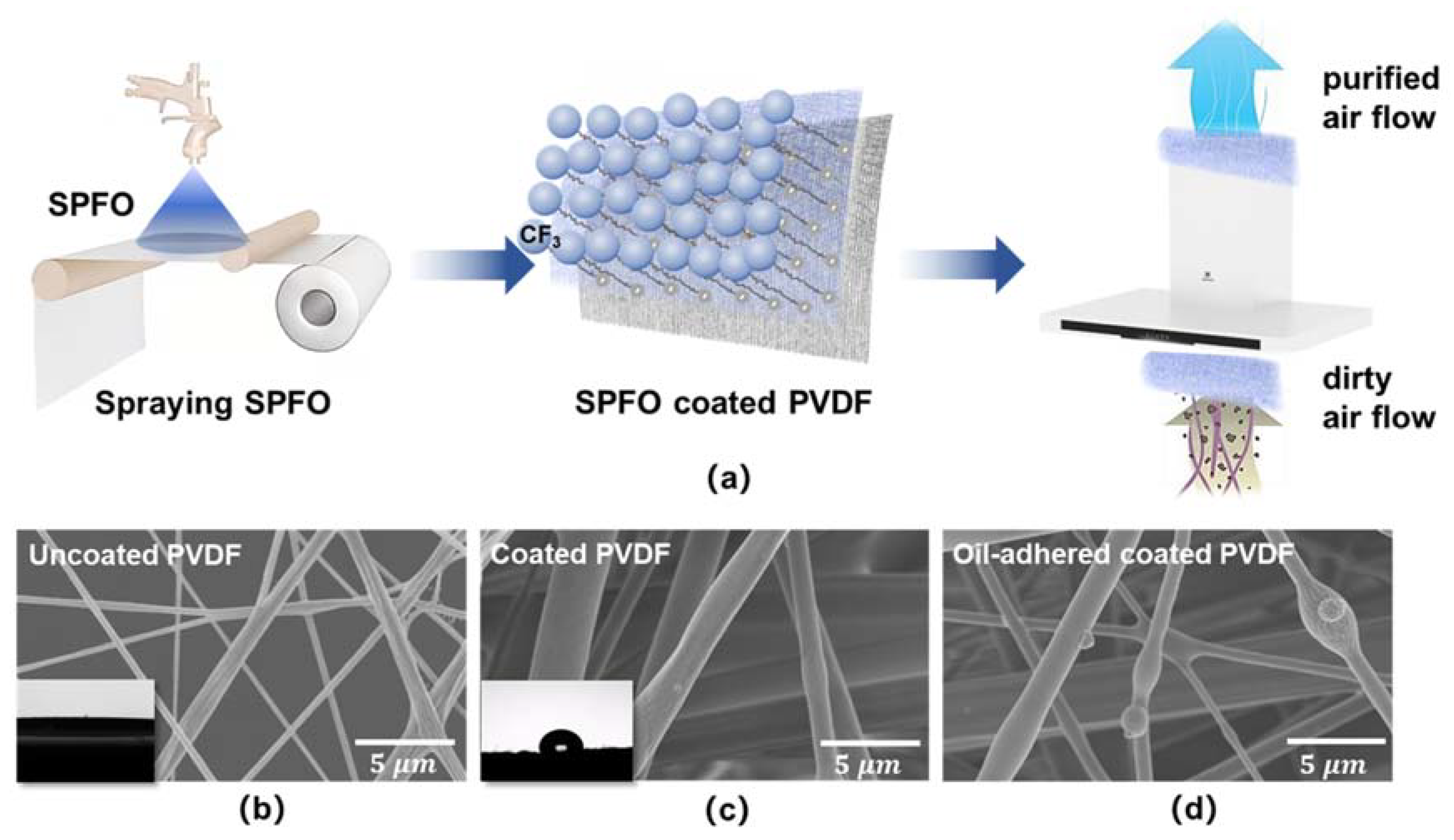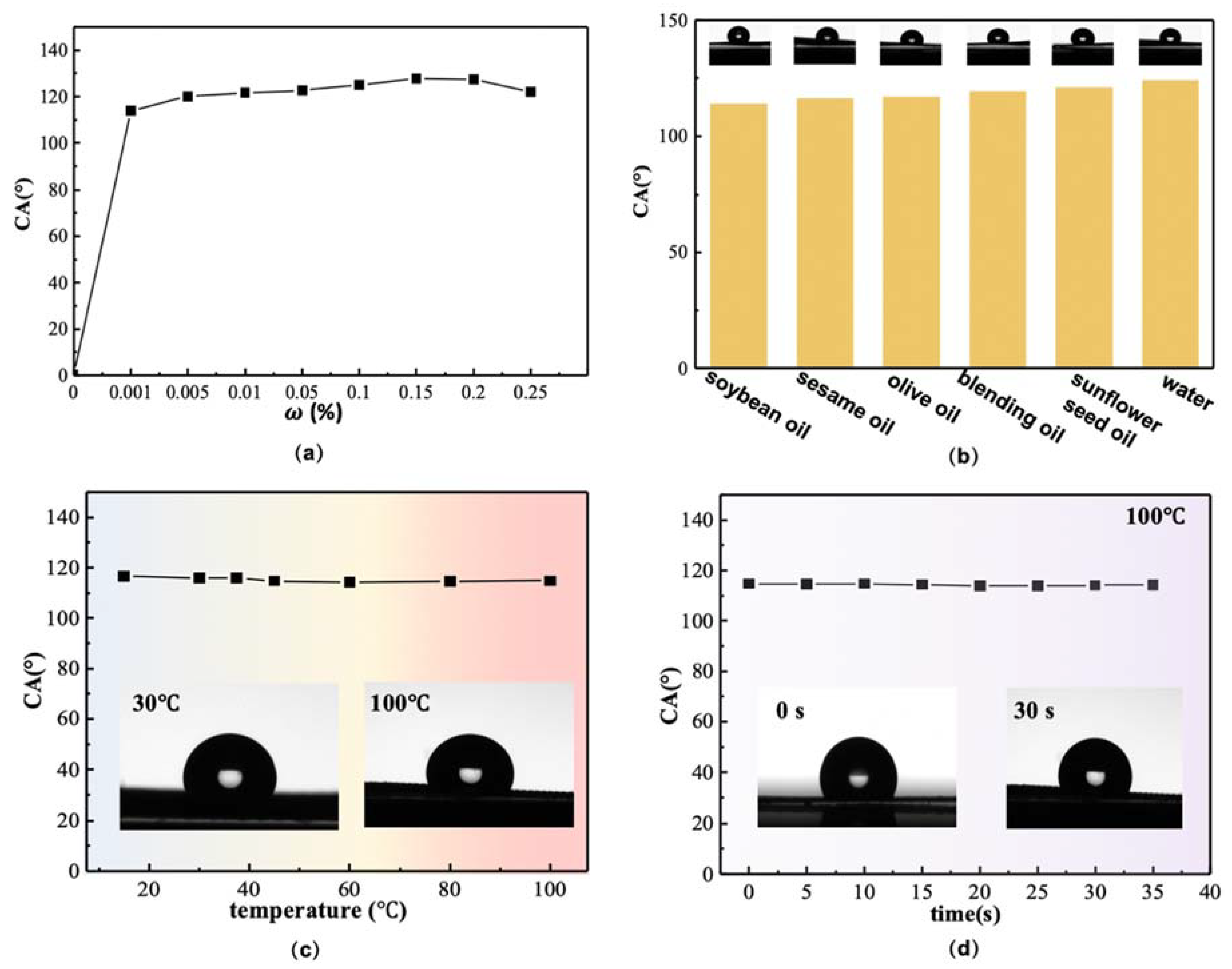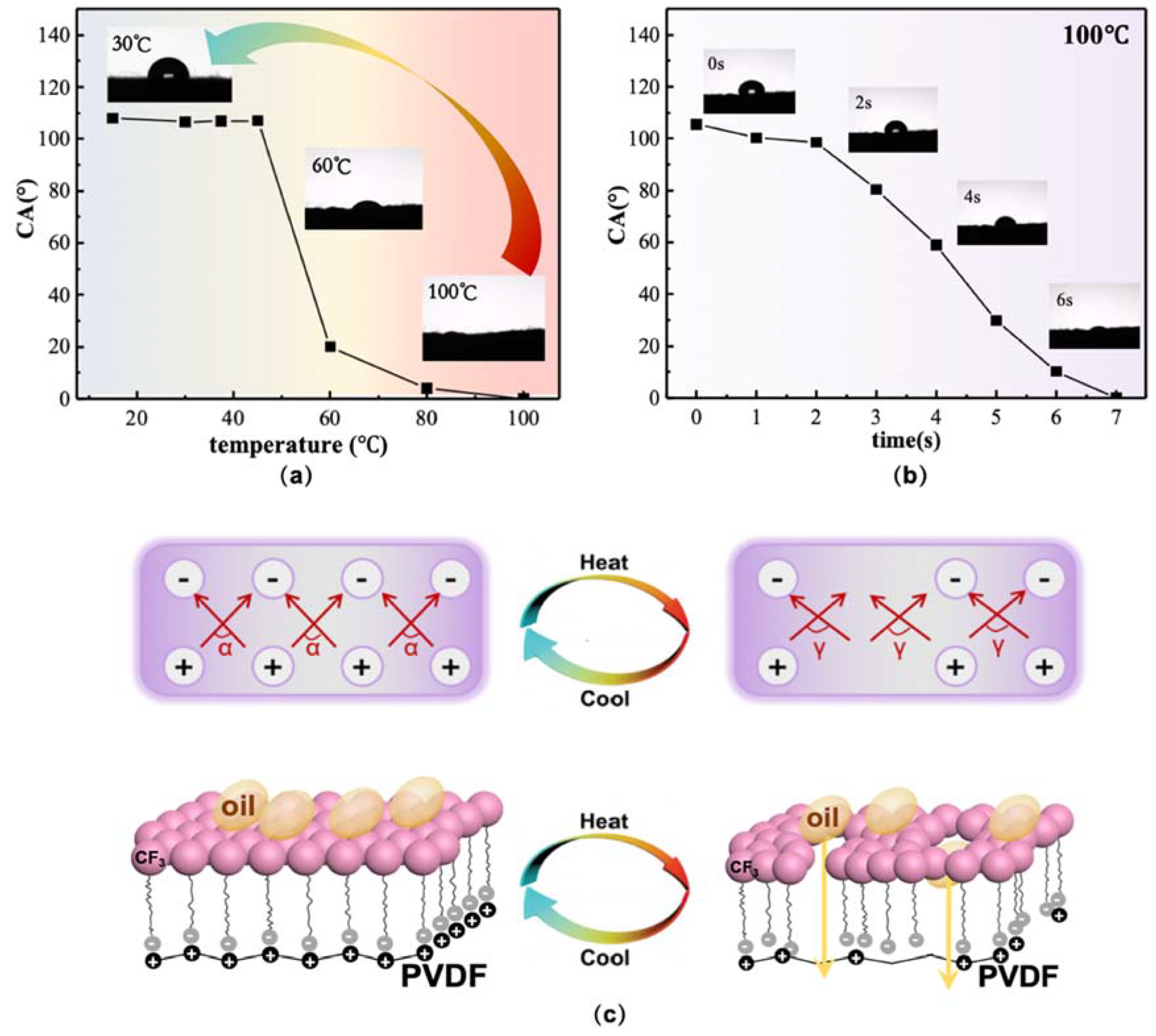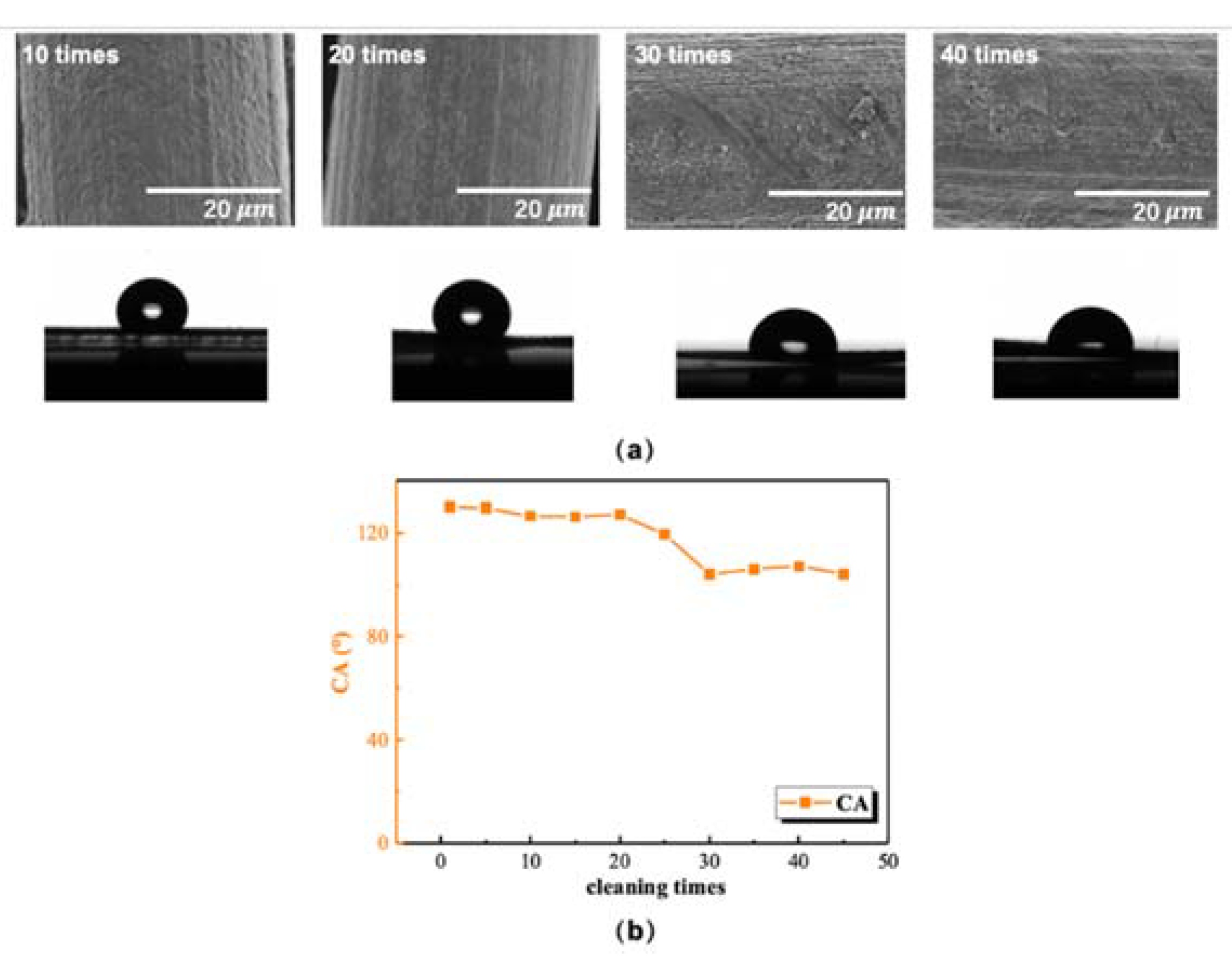The Fabrication of Oleophobic Coating and Its Application in Particulates Filtration
Abstract
:1. Introduction
2. Materials and Methods
2.1. Materials
2.2. Preparation of Oleophobic Coating Materials
2.3. Preparation of SPFO Coated PVDF Fibre Membranes
2.4. Static Contact Angle Measurement
2.5. SEM Characterisation
2.6. Filtration Performance Characterisation
3. Results and Discussion
3.1. Surface Morphology of SPFO Oleophobic Coating
3.2. Oleophobic Effect of SPFO Oleophobic Coating
3.3. Filtration Performance of SPFO-Coated PVDF Fibre Membranes
4. Conclusions
Author Contributions
Funding
Institutional Review Board Statement
Informed Consent Statement
Data Availability Statement
Acknowledgments
Conflicts of Interest
References
- Limchantra, I.V.; Fong, Y.M.; Melstrom, K.A. Surgical Smoke Exposure in Operating Room Personnel a Review. JAMA Surg. 2019, 154, 960–967. [Google Scholar] [CrossRef] [PubMed]
- Yi, H.H.; Huang, Y.H.; Tang, X.; Zhao, S.; Xie, X.; Zhang, Y. Characteristics of Non-Methane Hydrocarbons and Benzene Series Emission from Commonly Cooking Oil Fumes. Atmos. Environ. 2019, 200, 208–220. [Google Scholar] [CrossRef]
- Ganesan, K.; Sukalingam, K.; Xu, B.J. Impact of consumption of repeatedly heated cooking oils on the incidence of various cancers- A critical review. Crit. Rev. Food Sci. Nutr. 2019, 59, 488–505. [Google Scholar] [CrossRef]
- Wang, L.L.; Hu, W.Y.; Guan, Q.Q.; Du, G.Z.; Chen, T.; Wu, W.; Wang, Y.; Wang, X.R.; Xia, Y.K. The association between cooking oil fume exposure during pregnancy and birth weight: A prospective mother-child cohort study. Sci. Total Environ. 2018, 612, 822–830. [Google Scholar] [CrossRef]
- Graff, R.E.; Cavazos, T.B.; Thai, K.K.; Kachuri, L.; Rashkin, S.R.; Hoffman, J.D.; Alexeeff, S.E.; Blatchins, M.; Meyers, T.J.; Leong, L.; et al. Cross-cancer evaluation of polygenic risk scores for 16 cancer types in two large cohorts. Nat. Commun. 2021, 12, 970. [Google Scholar] [CrossRef] [PubMed]
- Zhang, N.; Han, B.; He, F.; Xu, J.; Zhao, R.J.; Zhang, Y.J.; Bai, Z.P. Chemical characteristic of PM2.5 emission and inhalational carcinogenic risk of domestic Chinese cooking. Environ. Pollut. 2017, 227, 24–30. [Google Scholar] [CrossRef] [PubMed]
- Deng, L.J.; Ma, Y.S.; Ma, P.; Wu, Y.; Yang, X.; Deng, Q.H. Toxic effect of cooking oil fume (COF) on lungs: Evidence of endoplasmic reticulum stress in rat. Ecotoxicol. Environ. Saf. 2021, 221, 112463. [Google Scholar] [CrossRef]
- Vaclova, T.; Grazini, U.; Ward, L.; O’Neill, D.; Markovets, A.; Huang, X.N.; Chmielecki, J.; Hartmaier, R.; Thress, K.S.; Smith, P.D.; et al. Clinical impact of subclonal EGFR T790M mutations in advanced-stage EGFR-mutant non-small-cell lung cancers. Nat. Commun. 2021, 12, 1780. [Google Scholar] [CrossRef]
- Suojalehto, H.; Ndika, J.; Lindstrom, I.; Airaksinen, L.; Karisola, P.; Alenius, H. Endotyping asthma related to 3 different work exposures. J. Allergy Clin. Immunol. 2021, 148, 1072–1080. [Google Scholar] [CrossRef]
- Chen, H.C.; Wu, C.F.; Chong, I.W.; Wu, M.T. Exposure to cooking oil fumes and chronic bronchitis in nonsmoking women aged 40 years and over: A health-care based study. BMC Public Health 2018, 18, 246. [Google Scholar] [CrossRef] [Green Version]
- Doney, B.; Kurth, L.; Syamlal, G. Chronic bronchitis and emphysema among workers exposed to dust, vapors, or fumes by industry and occupation. Arch. Environ. Occup. Health 2021, 77, 525–529. [Google Scholar] [CrossRef] [PubMed]
- Butnor, K.J.; Covington, J.; Taatjes, D.J.; DeWitt, J.; Von Turkovich, M.A. Fluorine detection in the lung tissue of a worker with interstitial pulmonary fibrosis and long-term occupational exposure to polytetrafluoroethylene and perfluorooctanoic acid. Ultrastruct. Pathol. 2020, 44, 496–500. [Google Scholar] [CrossRef] [PubMed]
- Chen, T.Y.; Fang, Y.H.; Chen, H.L.; Chang, C.H.; Huang, H.; Chen, Y.S.; Liao, K.M.; Wu, H.Y.; Chang, G.C.; Tsai, Y.H.; et al. Impact of cooking oil fume exposure and fume extractor use on lung cancer risk in non-smoking Han Chinese women. Sci. Rep. 2020, 10, 6774. [Google Scholar] [CrossRef] [PubMed] [Green Version]
- Ma, Y.S.; Deng, L.J.; Ma, P.; Wu, Y.; Yang, X.; Xiao, F.; Den, Q.H. In vivo respiratory toxicology of cooking oil fumes: Evidence, mechanisms and prevention. J. Hazard. Mater. 2021, 402, 123455. [Google Scholar] [CrossRef] [PubMed]
- Rynning, I.; Arlt, V.M.; Vrbova, K.; Neca, J.; Rossner, P.; Klema, J.; Ulvestad, B.; Petersen, E.; Skare, O.; Haugen, A.; et al. Bulky DNA adducts, microRNA profiles, and lipid biomarkers in Norwegian tunnel finishing workers occupationally exposed to diesel exhaust. Occup. Environ. Med. 2019, 76, 10–16. [Google Scholar] [CrossRef] [Green Version]
- Setiawan, W.K.; Chiang, K.Y. Silica applied as mixed matrix membrane inorganic filler for gas separation: A review. Sustain. Environ. Res. 2019, 29, 32. [Google Scholar] [CrossRef] [Green Version]
- Liao, D.L.; Shi, W.; Gao, J.; Deng, B.; Yu, R.J. Modified Camellia oleifera Shell Carbon with Enhanced Performance for the Adsorption of Cooking Fumes. Nanomaterials 2021, 11, 1349. [Google Scholar] [CrossRef]
- Hsieh, L.T.; Wang, Y.F.; Li, P.M.; Chen, K.C. Removal of Particle-bound Water-soluble Ions from Cooking Fume Using Bio-solution Wet Scrubber. Aerosol Air Qual. Res. 2011, 11, 508–518. [Google Scholar] [CrossRef]
- Xue, J.J.; Wu, T.; Dai, Y.Q.; Xia, Y.N. Electrospinning and Electrospun Nanofibers: Methods, Materials, and Applications. Chem. Rev. 2019, 119, 5298–5415. [Google Scholar] [CrossRef]
- Ifelebuegu, A.O.; Lale, E.E.; Mbanaso, F.U.; Theophilus, S.C. Facile Fabrication of Recyclable, Superhydrophobic, and Oleophilic Sorbent from Waste Cigarette Filters for the Sequestration of Oil Pollutants from an Aqueous Environment. Processes 2018, 6, 140. [Google Scholar] [CrossRef] [Green Version]
- Baig, N.; Saleh, T.A. Photochemically Produced Superhydrophobic Silane@polystyrene-Coated Polypropylene Fibrous Network for Oil/Water Separation. Chem.-Asian J. 2021, 16, 329–341. [Google Scholar] [CrossRef] [PubMed]
- Su, C.P.; Yang, H.; Song, S.; Lu, B.; Chen, R. A magnetic superhydrophilic/oleophobic sponge for continuous oil-water separation. Chem. Eng. J. 2017, 309, 366–373. [Google Scholar] [CrossRef]
- Yuan, Z.S.; Ke, Z.W.; Qiu, Y.H.; Zheng, L.J.; Yang, Y.; Gu, Q.S.; Wang, C.Y. Prewetting Polypropylene-Wood Pulp Fiber Composite Nonwoven Fabric for Oil-Water Separation. ACS Appl. Mater. Interfaces 2020, 12, 46923–46932. [Google Scholar] [CrossRef]
- Yang, Y.; Ali, N.; Bilal, M.; Khan, A.; Ali, F.; Mao, P.; Ni, L.L.; Gao, X.Y.; Hong, K.; Rasool, K.; et al. Robust membranes with tunable functionalities for sustainable oil/water separation. J. Mol. Liq. 2021, 321, 114701. [Google Scholar] [CrossRef]
- Zuo, J.-H.; Cheng, P.; Chen, X.-F.; Yan, X.; Guo, Y.-J.; Lang, W.-Z. Ultrahigh flux of polydopamine-coated PVDF membranes quenched in air via thermally induced phase separation for oil/water emulsion separation. Sep. Purif. Technol. 2018, 192, 348–359. [Google Scholar] [CrossRef]
- Senusi, F.; Ballinger, B.; Ismail, S. Enhancing the Performances of Polymeric PVDF Membranes for Oil/Water Separation by Hydrophilic and Underwater Oleophobic Surfaces Modification. Indones. J. Chem. 2020, 20, 545–553. [Google Scholar] [CrossRef]
- Zhu, X.; Tu, W.; Wee, K.-H.; Bai, R. Effective and low fouling oil/water separation by a novel hollow fiber membrane with both hydrophilic and oleophobic surface properties. J. Membr. Sci. 2014, 466, 36–44. [Google Scholar] [CrossRef]
- El-badawy, T.; Othman, M.H.D.; Adam, M.R.; Kamaludin, R.; Ismail, A.; Rahman, M.A.; Jaafar, J.; Rajabzadeh, S.; Matsuyama, H.; Usman, J. Braid-reinforced PVDF hollow fiber membranes for high-efficiency separation of oily wastewater. J. Environ. Chem. Eng. 2022, 10, 107258. [Google Scholar] [CrossRef]
- Wang, Y.J.; Gong, X. Special oleophobic and hydrophilic surfaces: Approaches, mechanisms, and applications. J. Mater. Chem. A 2017, 5, 3759–3773. [Google Scholar] [CrossRef]
- Zhao, D.; Peng, J.X.; Tang, X.F.; Zhang, D.D.; Qiu, X.H.; Yang, Y.L.; Wang, Y.P.; Zhang, M.N.; Guan, L.; Cao, T.B. Charge-induced local dewetting on polymer electrets studied by atomic force microscopy. Soft Matter 2013, 9, 9702–9708. [Google Scholar] [CrossRef]
- Lin, Z.H.; Gao, D.; Guan, L.; Zhang, M.N.; Zhu, X.Y.; Yang, Y.L.; Qiu, X.H.; Zhang, J.P. Charge-Pattern Indicated Relaxation Dynamics and Glass Transition of Polymer Thin Films Studied by Atomic Force Microscopy. J. Phys. Chem. C 2016, 120, 12157–12162. [Google Scholar] [CrossRef]
- Xu, M.Z.; Kang, H.; Guan, L.; Li, H.Y.; Zhang, M.N. Facile Fabrication of a Flexible LiNbO3 Piezoelectric Sensor through Hot Pressing for Biomechanical Monitoring. ACS Appl. Mater. Interfaces 2017, 9, 34687–34695. [Google Scholar] [CrossRef] [PubMed]
- Kang, H.; Qian, X.Q.; Guan, L.; Zhang, M.N.; Li, Q.; Wu, A.L.; Dong, M.D. Studying the Adhesion Force and Glass Transition of Thin Polystyrene Films by Atomic Force Microscopy. Nanoscale Res. Lett. 2018, 13, 5. [Google Scholar] [CrossRef]
- Zhang, F.; Kan, H.; Lin, Y.X.; Guan, L.; Aslan, H.; Zhang, M.N.; Niu, L.; Dong, M.D. Studying the Pyroelectric Effects of LiNbO3 Modified Composites. Nanoscale Res. Lett. 2020, 15, 106. [Google Scholar] [CrossRef] [PubMed]
- Lin, Y.X.; Zhang, Y.Q.; Zhang, F.; Zhang, M.N.; Li, D.L.; Deng, G.F.; Guan, L.; Dong, M.D. Studies on the electrostatic effects of stretched PVDF films and nanofibers. Nanoscale Res. Lett. 2021, 16, 79. [Google Scholar] [CrossRef]
- Li, X.P.; Shan, H.T.; Cao, M.; Li, B.A. Facile fabrication of omniphobic PVDF composite membrane via a waterborne coating for anti-wetting and anti-fouling membrane distillation. J. Membr. Sci. 2019, 589, 117262. [Google Scholar] [CrossRef]
- Sung, G.; Choi, M.C.; Nagappan, S.; Lee, W.K.; Han, M.; Ha, C.S. Polynorbornene/fluorosilica hybrids for hydrophobic and oleophobic coatings. Polym. Bull. 2013, 70, 619–630. [Google Scholar] [CrossRef]
- Ning, W.J.; Yang, Y.W.; Zhang, D.; Pan, R.M. Surface modification of sodium bicarbonate ultrafine powder extinguishing agent by environmental friendly fluorinated acrylate copolymers. Polym. Degrad. Stab. 2021, 187, 109558. [Google Scholar] [CrossRef]
- Antonietti, M.; Henke, S.; Thunemann, A. Highly ordered materials with ultra-low surface energies: Polyelectrolyte surfactant complexes with fluorinated surfactants. Adv. Mater. 1996, 8, 41–45. [Google Scholar] [CrossRef]
- Lochhaas, A.F.T.a.K.H. Surface and solid-state properties of a fluorinated polyelectrolyte-surfactant complex. Langmuir 1999, 15, 4867–4874. [Google Scholar] [CrossRef]
- Karoyo, A.H.; Sidhu, P.S.; Wilson, L.D.; Hazendonk, P.; Borisov, A. Counterion Anchoring Effect on the Structure of the Solid-State Inclusion Complexes of beta-Cyclodextrin and Sodium Perfluorooctanoate. J. Phys. Chem. C 2015, 119, 22225–22243. [Google Scholar] [CrossRef]
- Ojogun, V.A.; Lehmler, H.J.; Knutson, B.L. Cationic-anionic vesicle templating from fluorocarbon/fluorocarbon and hydrocarbon/fluorocarbon surfactants. J. Colloid Interface Sci. 2009, 338, 82–91. [Google Scholar] [CrossRef] [PubMed]
- Zhang, D.C.; Liu, J.J.; Jia, L.Z.; Wang, P.; Han, X. Speciation of VOCs in the cooking fumes from five edible oils and their corresponding health risk assessments. Atmos. Environ. 2019, 211, 6–17. [Google Scholar] [CrossRef]




| Filter | Salt Fine Particulate Matter | Oily Fine Particulate Matter | ||
|---|---|---|---|---|
| Filtration Efficiency (%) | Airflow Resistance (Pa) | Filtration Efficiency (%) | Airflow Resistance (Pa) | |
| Original PVDF | 99.41 | 26 | 98.37 | 26 |
| Oil-accumulated PVDF | 30.66 | 220 | 24.74 | 225 |
| SPFO coated PVDF | 94.12 | 69 | 89.43 | 69 |
| Oil-accumulated SPFO coated PVDF | 74.99 | 69 | 76.06 | 82 |
Publisher’s Note: MDPI stays neutral with regard to jurisdictional claims in published maps and institutional affiliations. |
© 2022 by the authors. Licensee MDPI, Basel, Switzerland. This article is an open access article distributed under the terms and conditions of the Creative Commons Attribution (CC BY) license (https://creativecommons.org/licenses/by/4.0/).
Share and Cite
Zhang, Y.; Qing, C.; Lin, Y.; Guan, Y.; Dai, W.; Yang, Y.; Deng, G.; Guan, L. The Fabrication of Oleophobic Coating and Its Application in Particulates Filtration. Coatings 2022, 12, 905. https://doi.org/10.3390/coatings12070905
Zhang Y, Qing C, Lin Y, Guan Y, Dai W, Yang Y, Deng G, Guan L. The Fabrication of Oleophobic Coating and Its Application in Particulates Filtration. Coatings. 2022; 12(7):905. https://doi.org/10.3390/coatings12070905
Chicago/Turabian StyleZhang, Yuqiong, Chenglin Qing, Yixuan Lin, Yunlong Guan, Wenhua Dai, Yingxia Yang, Gaofeng Deng, and Li Guan. 2022. "The Fabrication of Oleophobic Coating and Its Application in Particulates Filtration" Coatings 12, no. 7: 905. https://doi.org/10.3390/coatings12070905






